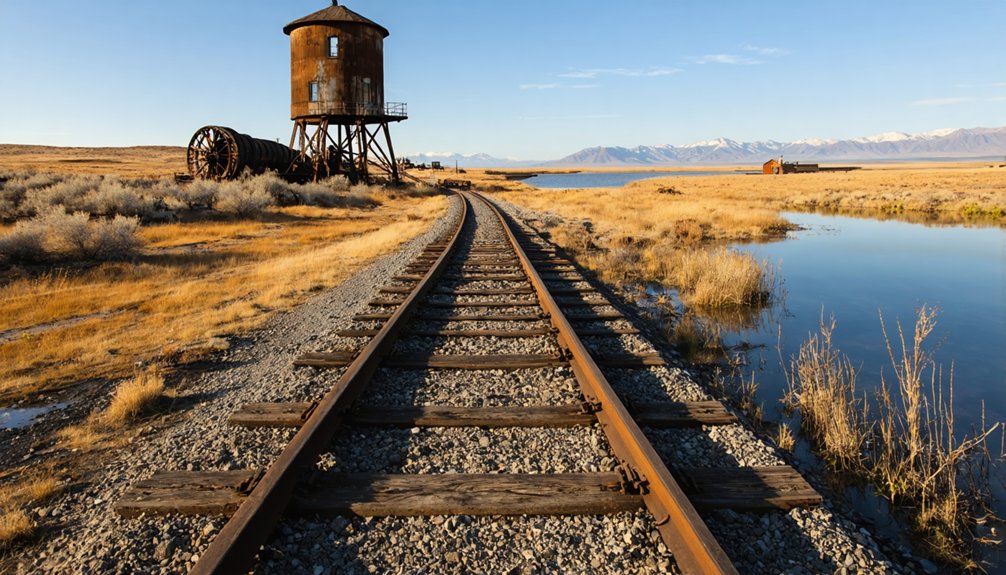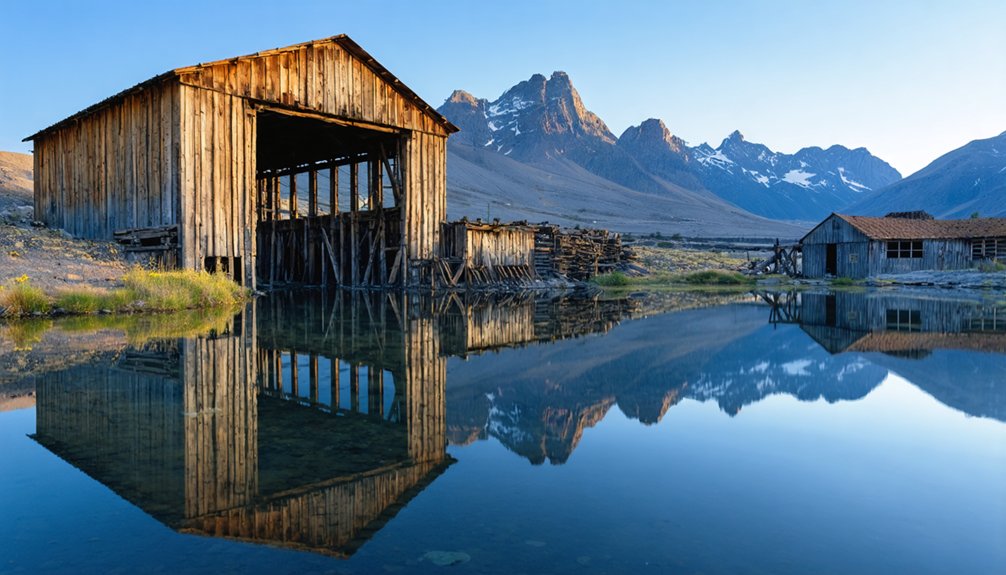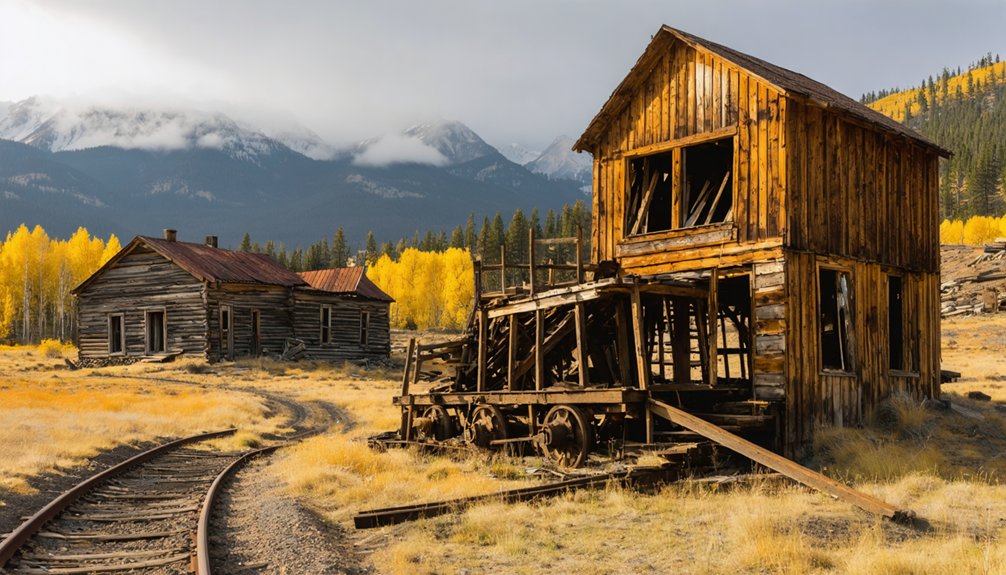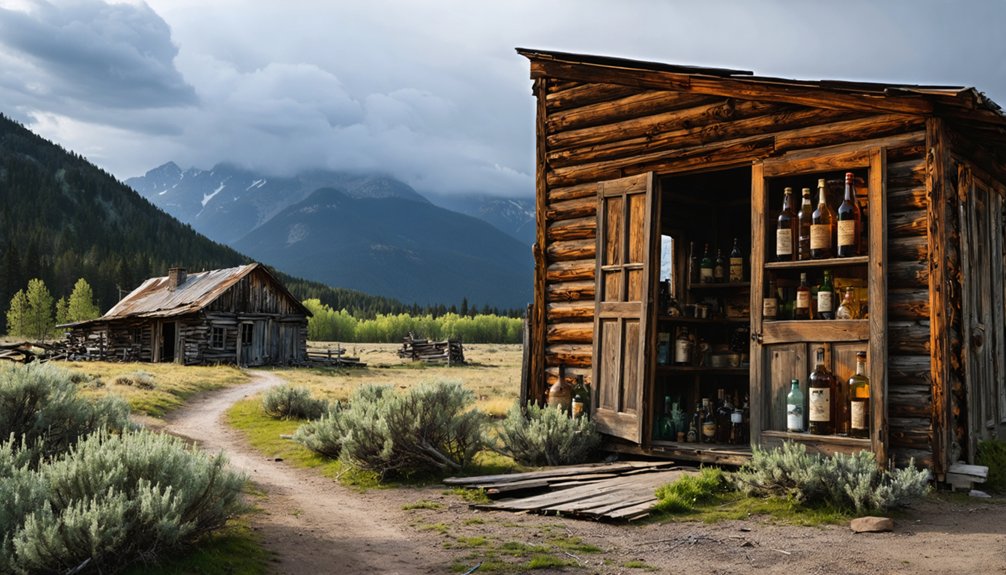You’ll find Black Lake‘s abandoned mining camp at 7,230 feet in Idaho’s Hells Canyon Wilderness, where gold mining operations flourished in the early 1900s. The Idaho Gold Coin Mining Company established a fifty-ton cyanide mill here in 1903, extracting $75,000 in gold bullion from the Summit vein before a fire destroyed their operation. Today, the site’s mining remnants, accessible via Black Lake Road (FS-112), reveal a fascinating story of technological innovation and frontier determination.
Key Takeaways
- Black Lake Ghost Town sits at 7,230 feet elevation in Wallowa-Whitman National Forest near Idaho’s Hells Canyon Wilderness.
- The settlement thrived during gold mining operations, featuring a fifty-ton cyanide mill built in 1903 by Idaho Gold Coin Mining Company.
- Mining infrastructure included a 6,000-foot wire rope tramway, timber cabins, and extensive tunnel systems in diorite and greenstone formations.
- The town’s decline began after a devastating fire destroyed the mill in October 1903, though mining continued through deep cross-cut tunnels.
- Remnants of mining operations, including surface disturbances and hydraulic pits, still exist as evidence of the site’s industrial heritage.
Location in the Seven Devils Mountains
Nestled in the rugged Wallowa-Whitman National Forest, Black Lake sits at 7,230 feet elevation on the southeast edge of Idaho’s Hells Canyon Wilderness.
Perched high in Idaho’s wild mountains, Black Lake offers a pristine alpine sanctuary at over 7,000 feet above sea level.
You’ll find it at the intersection of Black Lake-Horse Heaven Trail #214 and Six Lakes Basin Trail #218, providing key Wilderness access points into the backcountry. The lake is accessible via FS-112/Black Lake Road, though high-clearance vehicles are recommended.
The lake’s position in the Seven Devils Mountains puts you in one of Idaho’s most dramatic landscapes, where seven peaks soar above 9,000 feet. Hikers should plan to carry extra water since there is a nine-mile waterless stretch along sections of the wilderness trail system.
The surrounding terrain features steep forests, alpine meadows, and striking elevation changes typical of the western Rockies.
You’re positioned perfectly to explore the broader Seven Devils range, which forms part of the Idaho-Oregon border and spans over 218,000 acres of untamed wilderness.
Early Mining Claims and Operations
While the rugged terrain presented significant challenges, mining operations at Black Lake took hold within distinctive diorite and diabasic igneous formations, characterized by extensive blue and gray crystalline limestone belts. At an elevation of 7,201 feet, the mine site provided unique operational demands for its workers.
The historical significance of the area centers on the Idaho Gold Coin Mining Company‘s operations, which implemented advanced mining techniques including a fifty-ton cyanide mill.
You’ll find that nearly vertical fissures in diorite and greenstone hosted valuable mineral deposits, with the Summit vein being the most extensively developed.
In 1903, before the mill’s destruction by fire, the operation produced $75,000 in gold bullion. Following this setback, development shifted to creating a deep cross-cut tunnel, designed to tap the principal vein 400 feet below its existing level.
Gold Mining Technology and Methods
You’ll discover that Black Lake miners employed both simple tools like rocker boxes and sluices with perforated steel bottoms to separate fine gold from heavy sands.
The ambitious operation later added a sophisticated 6,000-foot wire rope tramway system that transported ore across Black Lake to the processing facility.
At the mill site, workers crushed and concentrated the quartz and iron pyrite ores, which typically yielded $8 to $20 per ton in gold values, before a fire destroyed the operation.
Mining Equipment and Tools
Gold mining at Black Lake began with simple placer operations in 1863, relying on basic hand tools and manual processing methods.
You’d find prospectors using pans, rockers, and sluice boxes to process river gravels, as mining innovations were limited in the district’s early days.
The equipment evolution became evident by the early 1900s when the Idaho Gold Coin Mining Company built a 50-ton cyanide mill.
They’d abandoned primitive tools in favor of machine drills and air compressors for their 460-foot-deep tunnels.
You’ll notice the shift from basic placer mining to more sophisticated hard rock operations, though they never implemented hydraulic giants or dredges.
Despite these advances, you’d still face significant challenges – the rugged terrain and harsh weather limited equipment transportation, while the lack of electrification meant relying on steam power or manual labor.
Like many mining operations of the era, Chinese miners frequently worked the lower-grade deposits using traditional methods passed down through generations.
The high costs and prolonged efforts required for hard-rock mining often led to mixed results in gold extraction success.
Gold Extraction Techniques
The evolution of gold extraction at Black Lake mirrored ancient techniques dating back to 4000 BCE.
You’d have seen miners initially using basic gold panning and sluicing methods to recover alluvial deposits, just as the Mesopotamians did thousands of years ago. As operations expanded, they’d incorporate more advanced mechanical processes like crushing and grinding, powered first by water wheels and later by steam engines.
When they discovered underground deposits, miners employed fire-setting to crack stubborn rock faces and salt cementation for purifying gold-silver alloys. The mercury amalgamation process was later introduced to capture fine gold particles that would have otherwise been lost.
They’d later shift to hydraulic mining, using high-pressure water to expose gold veins – a technique that revolutionized extraction efficiency. The integration of borax flux and mechanical concentration methods through strategically placed milling plants helped maximize gold recovery from lower-grade ores. The establishment of organized mining guilds during this period brought structure and standardization to the extraction processes.
Cyanide Mill Operations
As mining operations evolved at Black Lake, a significant advancement came in 1903 when Idaho Gold Coin Mining Company constructed its fifty-ton cyanide mill. The facility’s innovative cyanide safety protocols enabled efficient processing of sulfide-rich ores that traditional methods couldn’t handle, extracting about half a pound of gold per ton at a cost of $1.30.
You’ll find the economic impact was substantial – the mill produced $75,000 in gold bullion during its brief run. Despite the challenging terrain and seasonal access limitations, the operation maintained steady production through mechanized drilling and air compressors.
Unfortunately, a devastating fire in October 1903 destroyed the mill, halting operations. The company responded by shifting focus to underground development, creating a 1,400-foot crosscut tunnel to access veins 400 feet below previous levels.
Transportation Challenges and Solutions

Located deep within Idaho’s rugged terrain, Black Lake faced substantial transportation obstacles that shaped its development and eventual decline.
You’ll find that the mountainous landscape and harsh weather conditions made traditional transportation methods nearly impossible, forcing residents to adapt through transportation innovations and community collaboration.
The town’s remote location required creative solutions.
You’d have seen pack animals and horse-drawn vehicles maneuvering the difficult terrain, while locals worked together to maintain crude dirt roads.
During winter months, heavy snowfall often isolated the community, making self-sufficiency crucial.
Winter’s heavy snows cut Black Lake off from the outside world, forcing residents to depend entirely on their own resources.
Though railways served some nearby mining towns, Black Lake relied primarily on community-based solutions, with residents forming informal networks to share resources and maintain essential transportation links.
Similar to Silver City’s decline, these challenges ultimately contributed to the town’s abandonment, though some gravel roads still provide limited access today.
Like many of Idaho’s ghost towns, the arid climate helped preserve the remaining structures and trails that once served as vital transportation routes.
Life in the Mining Camp
You’d find yourself waking before dawn in a basic cabin or tent, joining fellow miners for a hurried breakfast before heading to your physically demanding shift at the Black Lake mines.
Your daily routine would involve working alongside a diverse crew of immigrants and specialists, from Austrian laborers to skilled engineers, as you extracted ore from the area’s diorite and greenstone formations. Rough living conditions and the absence of proper society meant workers had to be resilient to survive in the camp environment.
At day’s end, you’d return to the isolated camp community where basic medical facilities and communal support helped miners cope with the harsh mountain conditions and occupational risks.
Daily Worker Routines
When the first rays of sunlight crept over Black Lake’s mountains, miners were already preparing for their grueling 10-12 hour workday.
You’d find workers dispersed throughout the operation – drillers heading underground, mill operators checking machinery, and timbermen inspecting support beams for safety.
Throughout your shift, you’d alternate between drilling, blasting, and mucking, following strict safety protocols before detonations.
If you weren’t underground, you might be maintaining water systems, repairing equipment at the blacksmith shop, or operating the tramways that transported ore to the mills.
During winter months, you’d focus primarily on underground work to escape harsh weather.
When your shift ended, you’d join fellow miners in community tasks like road maintenance or camp repairs, ensuring Black Lake’s infrastructure remained solid for the next day’s operations.
Camp Living Conditions
Despite the promise of mining riches, life in Black Lake’s camp offered only rudimentary comfort amid harsh conditions.
You’d find yourself living in simple timber cabins with minimal insulation against Idaho’s unforgiving weather. The camp infrastructure was basic – outhouses served as toilets, and you’d heat water on small stoves for occasional baths.
Living conditions were challenging, with unreliable water sources often contaminated by mining operations. Your food options would be limited to preserved goods and basic staples, as supply lines were tenuous at best.
You’d face constant safety hazards, from unstable mine shafts to wildlife encounters. The camp’s social fabric remained unstable due to the transient nature of workers, while limited law enforcement meant you’d need to stay alert for potential threats.
The Idaho Gold Coin Mining Company Era

Around 1915, the Idaho Gold Coin Mining and Milling Company emerged as a significant force in the Seven Devils District by acquiring the Black Lake Mine along with several valuable claims, including the Maid of Erin and Summit properties.
Under the ownership of Henry A. and B. F. Salzer, the company’s mining economics centered on extracting gold from nearly vertical fissures in diorite and greenstone formations, reaching depths of 460 feet through underground adits.
The operation’s historical significance peaked in 1903 when their fifty-ton cyanide mill produced $75,000 in gold bullion. However, a devastating fire destroyed the mill that October, marking a turning point in production.
The company’s presence drove regional development, spurring road construction through the rugged Seven Devils range and supporting local freight transport.
Natural Resources and Geological Features
The geological foundation that enabled Black Lake’s mining boom tells a complex story of diverse formations and mineral wealth. You’ll find distinctive diorite and diabasic igneous formations throughout the area, alongside significant limestone deposits that showcase the region’s geological diversity.
The surrounding Black Lake gold district proved particularly attractive for mineral exploration, though specific deposit details remain limited in documentation.
The lake itself sits amid varied soil compositions, including Blinn-Lacy Santa and Lumberjack Variant series.
You’ll notice the water level fluctuates seasonally by 1.5 to 2.0 meters, influenced by snowmelt and runoff.
The lake’s complex hydrology, with its 10.5-month flushing time and multiple tributaries, continues to shape the landscape while supporting both recreational activities and the surrounding agricultural economy.
The Rise and Fall of Black Lake Mining

When prospectors discovered gold at the head of Granite Creek tributary in 1893, Black Lake’s mining story began to unfold.
The Idaho Gold Coin Mining and Milling Company quickly established control, consolidating claims including the “Maid of Erin” and “Summit” groups.
The mining community dynamics centered around underground operations targeting gold-bearing fissures.
Preserving Black Lake’s Mining Legacy
Situated within Idaho’s Frank Church-River of No Return Wilderness, Black Lake’s mining legacy faces unique preservation challenges due to its remote location and environmental sensitivity.
The area’s historical significance spans over a century, with industrial archaeology revealing trenches, tunnels, and abandoned equipment that tell the story of past mining operations.
Historic trenches and abandoned machinery at Black Lake stand as silent witnesses to a century of Idaho’s mining endeavors.
You’ll find evidence of mining preservation efforts throughout the region, where historical documentation carefully catalogs surface disturbances, hydraulic pits, and dredging patterns. These remnants provide essential insights into early mining methods and community life.
While architectural surveys remain limited, the surviving structures in the Seven Devils area offer glimpses into the built environment of historic mining camps.
However, preservation efforts must balance protecting this mining heritage with environmental concerns, particularly regarding water quality and wildlife habitat in the Burntlog Creek Wild and Scenic River Corridor.
Frequently Asked Questions
What Was the Total Population of Black Lake During Its Peak?
You’ve stumbled upon a mining boom mystery – like those ghost stories you love hearing. Unfortunately, the exact peak population of Black Lake isn’t documented in historical records.
Are There Any Remaining Structures or Ruins at Black Lake Today?
You’ll find no standing buildings today, but you can explore the historical significance through remaining mill foundations, visible mining equipment, and the mine tunnel high above the lake.
Did Any Notable Accidents or Deaths Occur in Black Lake’s Mines?
You won’t find records of notable mine safety incidents or tragic events at these specific mines. While mining was dangerous work, historical documents don’t mention any significant accidents or deaths here.
What Happened to the Mining Equipment After Operations Ceased?
You won’t find clear records of the mining equipment’s fate after Black Lake Mine closed. Despite historical preservation efforts in Idaho’s ghost towns, the equipment’s final disposition remains a mystery.
Were There Any Significant Native American Settlements Near Black Lake?
You’ll find the Coeur d’Alene and Kootenai Native Tribes established significant settlements near Black Lake, where they fished, hunted, and maintained their cultural heritage through generations before European settlement.
References
- https://pinintheatlas.com/travel-blogs/ghost-towns-of-idaho/
- https://pinintheatlas.com/travel-blogs/lake-valley-ghost-town/
- https://www.thegoldminehotel.com/ghost-towns-and-haunted-places-in-idaho
- https://history.idaho.gov/wp-content/uploads/2018/12/0116.pdf
- https://idaho-forged.com/idahos-ghost-towns-eerie-yet-approachable/
- https://idahogeology.org/pub/Staff_Reports/1997/S-97-9.pdf
- https://www.onlyinyourstate.com/trip-ideas/idaho/id-minidoka-camp
- https://www.idahoaclimbingguide.com/southern-seven-devils-access/
- https://visitidaho.org/travel-tips/backpacking-the-seven-devils-loop-trail/
- https://www.sbbchidaho.org/PDF/Black Lake to Emerald Lake Trail.pdf



